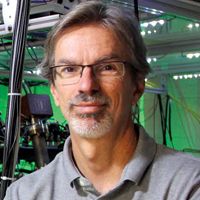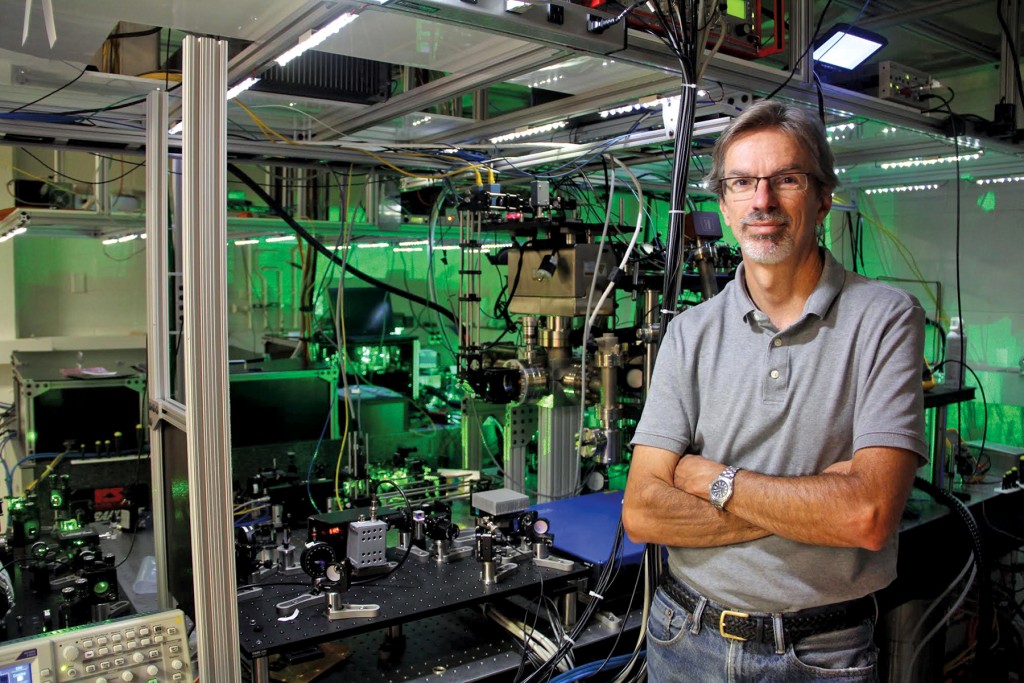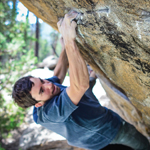STEVE ROLSTON ’80 WANTS TO START A QUANTUM REVOLUTION


By Gabriel Popkin ’03
In 1965, the same year he won the Nobel Prize, theoretical physicist Richard Feynman told an audience at MIT, “I think I can safely say that nobody understands quantum mechanics.” In other words, not even the world’s top physicists fully grasped the theory they had developed to describe reality at the atomic scale.
Steve Rolston ’80 was a young child when Feynman made his now-famous pronouncement. But 50 years later, Rolston not only understands quantum mechanics, he is using it to do extreme experiments and build new technology that could change our world.
Rolston is co-director of the Joint Quantum Institute, or JQI, a research center headquartered at the University of Maryland’s College Park campus. The things he and his colleagues do in their labs would amaze the Feynman of 1965, when the transistor and the laser were but recent inventions. Now ubiquitous in our technology, they use what Rolston calls the “mundane” parts of quantum mechanics—for instance, the fact that electric charge and light are, at the microscopic level, actually tiny particles rather than continuous fluids or substances.
But quantum mechanics also reveals truths that are far stranger. For instance, a fundamental particle—like an electron—can be in more than one place at the same time, and two particles can remain intimately “entangled” across vast distances. Physicists still debate how to interpret these ideas, but in the past two decades they’ve also started using them to build things. In his lab, Rolston and colleagues are exploring ways to store information using atoms and resistance-free electric currents. Although motivated mainly by scientific curiosity, these experiments could have payoffs far beyond the lab; they could lead to powerful new “quantum computers,” or to communication and encryption technology that would render much of our current information security infrastructure obsolete.
“What we’re trying to do is start the second quantum revolution, where we start using the other half of quantum mechanics—the crazy half—to do new science, new technologies,” Rolston says. “We’re still at the infancy of figuring out how we’re going to use this.”
While JQI has established itself as one of the world’s top quantum physics research institutes, it does have competition. The British government is pouring more than £100 million into quantum physics research. Well-funded efforts also exist in Japan and other European countries, and Google recently hired a large team of quantum physicists. So far, physicists are still figuring out how to control quantum devices well enough to reliably store and transmit information. But many hope that within the next few decades, quantum information technology could hit the market.
Rolston has the tall, lanky build of a long-distance biker, and indeed he often spends weekends biking on Maryland’s country roads. He grew up in New Jersey, and his parents were chemists. By the time he got to Wesleyan, he knew two things: He liked science, and he didn’t want to do chemistry. So he took physics instead, enjoying courses with Professor Ralph Baierlein and launching his research career in the lab of Professor Tom Morgan; they collaborated on studies of colliding hydrogen atoms. “Of more than 50 undergraduates who have worked with me, Steve is one of a handful of the best: highly motivated and deeply involved with physics and physical phenomena,” Morgan says.
After graduate school—Stony Brook University on Long Island—and a postdoc at Harvard with Gerald Gabrielse, one of the leaders in studying the exotic substance known as antimatter, Rolston was planning to continue studying antimatter at CERN in Geneva, Switzerland. In 1988, however, he was lured away to Bill Phillips’ lab at the National Institute for Standards and Technology (NIST) in Gaithersburg, Md. Phillips had just figured out how to cool atoms to extraordinarily low temperatures using lasers, a discovery for which he would be awarded the 1997 Nobel Prize in Physics. This discovery gave physicists a new level of access to quantum phenomena, which can generally be studied only at very low temperatures. Rolston “came at what you might call just the right time,” Phillips says, “when there was this huge acceleration of new experiments and new ideas. He was part of that and contributed a lot.”
For one of those new experiments, Rolston decided to see if he could use Phillips’ laser cooling techniques to make a plasma—a state of matter in which protons and electrons are not bound together in atoms, but exist more like two intermingling soups. Normally, plasmas are hot—the interior of the sun is a plasma, for instance, as is a candle flame. No one had ever made a cold plasma, but Rolston figured that NIST was as good a place as any to try. After several years of effort, Rolston created a plasma whose temperature was just a few degrees above absolute zero. He published the work in 1999 and launched a new subfield of physics.
In 2003, Rolston got a job offer from the University of Maryland, which was aiming to move into the top tier of U.S. public research universities. “I was 45, mid-career; I was interested in teaching,” Roston recalls. “I had always imagined an academic career.”
Three years later, with strong backing from Phillips, NIST and Maryland formed JQI, an institute designed to merge NIST’s mission and sizable resources with the university’s flexibility and curiosity-driven research. Rolston became its co-director.
Rolston is quick to remind me that despite frequent mention of possibilities like quantum computers, JQI still does basic physics research, and any real-world applications are at least a decade or two away. Nevertheless, entities that aren’t purely curiosity-driven have taken interest: The National Security Agency has partnered with Maryland to advance the research, and the technology giant Lockheed Martin invested $5 million in quantum research in 2014. Part of Rolston’s job is to attract such outside partnerships.
Rolston still finds time for his own research—and quite a bit of it. He took me to his basement lab recently to show me one of the four experiments he leads or co-leads. In this study, he’s trying to get supercold atoms to share quantum information with resistance-free electrical devices known as superconductors. Quantum information can be stored very stably in the electron energy states of atoms, but trapping even a few of them requires complex and expensive apparatus. Superconductors are relatively easy to manufacture and manipulate, but the information stored on them, typically in electric currents, is much less stable. In principle, a device that gets them to work together could harness the advantages of both, but each has different requirements—atoms are trapped by laser light, for example, but superconductors don’t work when illuminated. “It’s a ridiculously difficult experiment,” Rolston says. And that’s why it’s a good experiment for Rolston, adds colleague Trey Porto. “Nothing daunts him at all.”
The experiment is splayed out over a large table: To make things cold enough for quantum effects to emerge, Rolston uses a helium dilution refrigerator, vacuum pumps, and a dizzying array of lasers, lenses, and mirrors. It looks utterly unlike any computer I’ve ever seen. Earlier I had asked Phillips whether it’s realistic that we will ever have such devices in our houses. He reminded me that the first digital computers in the 1940s were made of vacuum tubes that took up an entire room and burned out every few hours. Those machines were less powerful than an ordinary wristwatch is today, and no one thought regular people would ever own one. Now we all have dozens—in our phones, our cars, and even our washing machines. Whether cutting-edge experiments like Rolston’s will point the way to spectacular new technologies remains to be seen. But, Phillips adds, “We’re never going to know if we don’t try.” —Gabriel Popkin ’03
Gabriel Popkin is a science and environmental writer based in Mount Rainier, Md. He has written for Nature, Science, and Johns Hopkins Magazine. He earned his bachelor’s in physics at Wesleyan. See more of his writing at gabrielpopkin.com.

